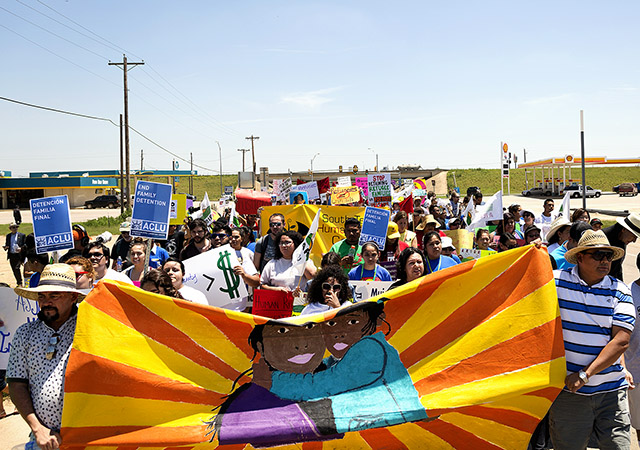Immigration Attorney Says Family Detention Centers Are Illegal

More than 500 protesters gathered on May 2 in Dilley to demand that the Obama administration close the family detention center on the outskirts of the town. Photo by Miguel Gutierrez Jr/Reporting Texas
By Lucia Benavides
For Reporting Texas
“Refugees are not criminals.”
“End for-profit detention centers.”
Those were some of the slogans on signs carried by more than 500 protesters marching down the dusty roads of Dilley, southwest of San Antonio, on May 2. Their demand: that the Obama administration shut down Dilley’s detention center for undocumented immigrant families, the country’s newest and largest.
The 2,400-bed South Texas Family Residential Center is next to a prison and surrounded by hundreds of acres of undeveloped land. It was built last December to deal with the influx of undocumented women and children who came to the United States last summer, seeking asylum from pervasive violence in their home countries.
The protesters— families, activists, lawyers and priests of various ages, racial backgrounds and religious affiliations—stood outside the facility for more than an hour, hearing personal testimonies from former detainees.
A recent report from the United States Conference of Catholic Bishops and the Center for Migration Studies shows that the number of undocumented individuals in detention has grown markedly in recent years—from 85,000 in 1995 to more than 440,000 in 2013.
Last summer’s immigrant surge led to a sudden growth in family detention centers. Facing mounting pressure from immigration advocates and lawyers, Sarah Saldaña, director of Immigration and Customs Enforcement (ICE), announced on May 13 a set of limited reforms that will, among other things, give lawyers more working space to meet with clients inside the facilities. Saldaña also promised “optimal level of care” for detainees.
Barbara Hines, an immigration attorney since 1975 and former co-director of the Immigration Clinic at the University of Texas at Austin, said in a recent telephone interview that reform won’t solve the problem: There is no humane way to house women and children inside such centers, she argued. Hines shared her thoughts about the legality of current government policies and possible alternatives.
Q. Who are the women and children seeking asylum?
A. The families are overwhelmingly Central Americans. They are fleeing the violence … in their home countries, which is rampant gang violence, domestic violence, gender-based violence, or their children are being recruited by the gangs as they get older. When they come across the border, the first step is to pass the “credible fear interview,” a threshold interview that gets you out of expedited removal [a deportation process]. Basically, they have to prove that they would be persecuted in their home country. If they pass, they’re eligible to be released on bond. If not, they have to pursue their full asylum claim in detention.
Q. Who monitors what’s going on inside these centers?
A. These facilities are not licensed by the state of Texas. [T]he Flores settlement [agreement] … says all children under ICE’s custody must be held in a state-licensed facility. Advocates, activists and lawyers are the only people monitoring [these places]. There’s no oversight. [Note: Approved by a federal judge in 1997, the Flores settlement resolved years of litigation over the detention of undocumented immigrant children and established national standards for detention.]
Q. So if it violates the Flores agreement, is it legal for the U.S. to place children in detention centers?
A. There’s no [U.S.] law that says [children] can’t be put in detention centers, but it [violates international law standards]. And it is illegal because it violates the Flores agreement. [Children] also can’t be held in secured facilities, and these are clearly secured facilities. ICE calls it a residential center, but the children are not free to leave and the families’ entire existence is regimented.
Q. If there’s no oversight, who’s accountable for the treatment of the women and children?
A. [Dilley and another detention facility, the Karnes County Residential Center] are run by a private prison operating on a profit motive, so they would be responsible, and then ICE would be responsible.
Q. What other options exist as alternatives to detention centers?
A. Sending the women to the family members that they came to join – almost all of them have family members here. The other thing is to send them to a community supervision program. The money that ICE spends on locking these families up, which is over $300 a day [per person], could be used for alternatives to detention: Case supervision, case management, housing and, in the most extreme cases, ankle-monitoring.